Content marketing growth is about evolution, not revolution.
There has been no revolution in the content marketing space. People have been publishing content since the days of cavemen carving on cave walls. The rapid fusion of search and social digital technologies combined with a rapid desire from consumers and audiences to engage in new and creative ways has put content marketing as the hotspot on the search marketing ‘heat map’.
There is no doubt that growth and interest has evolved over time and has been heavily influenced by Google’s algorithmic changes (Panda, Penguin, and Hummingbird).
Every individual is now a content marketer and every organization is a publisher right?
Wrong.
Beyond Content 101: Strategy to Scale vs. Tactical Noise

The Internet is awash with content ideation and best practice for creating and distributing content. In just under 0.28 seconds, the mighty Google served me with over 1,070,000,000 results. Many are fantastic, but many more crowd the market with noise and confusion.
Clearly, organizations are now becoming more content savvy and consuming media at maximum capacity. However, the key question, challenge, and opportunity for your business doesn’t lie within a tactical, 101, best practice document.
The answer lies within the heart of a business, its culture, and how it scales its operation and produces quality and relevant content efficiently.
The Real Issue: Scaling and Measuring Quality Content
To address the real issue of scale, quality, and measurement, businesses must focus on how to target, structure, and build sustainable strategies and frameworks.
A clear strategy and process leads to far more effective implementation of tactics. Unfortunately many businesses focus on too may tactics (for example, B2C tactics in a B2B market) and in-between all the confusion and mayhem objectives and aims are lost.
Solutions lie “embedded” within culture and the subsequent strategy and process that follow.
A 2014 B2B survey from Joe Pulizzi and the Content Marketing Institute highlighted statistics showing the challenges of content production:
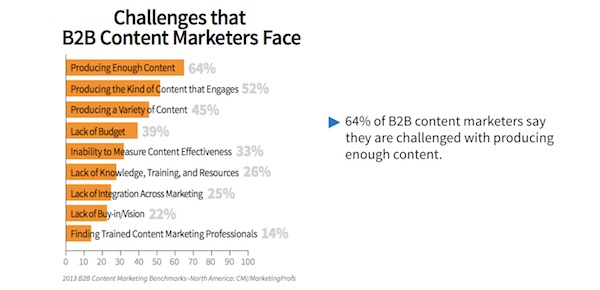
The real business challenge with content marketing lies within production and scale. It begins with a streamlined strategy that gives you scope, process, and bandwidth to execute on new and innovative content marketing tactics without the mayhem.
If you don’t do this, then your business faces many issues across resource, quality, and RAM (Random Acts of Marketing and Social Media).
As Pam Moore puts it in her excellent article, “These usually end up smack in the middle of projects.”
Teams get sidetracked by RAM, which eats into business time, ROI, budget, and free time; a key source of frustration that many true content marketers can relate to.
Sustainability and success rely not just on content creation best practice, but best practice around internal protocol, asset management, and talent management.
A Content Marketing Business Solution – Built For Scale
If you want to make the most of the content marketing evolution, expand upon tactical execution across content, search, and social, and scale to become a “publisher,” it’s essential to build a framework that works.
In a recent ClickZ article, Aaron Kahlow set down a blueprint for content marketing success by stating, “You really need a blueprint – a guide – to help you get and stay on track.”
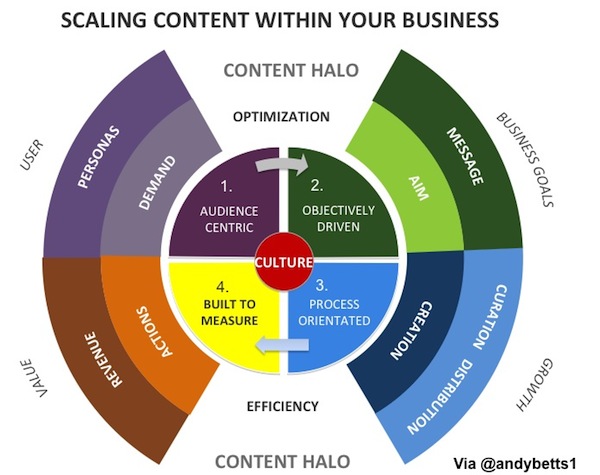
To scale quality and relevant content, your culture needs to become the key driver of the following model.
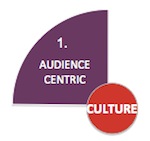
The best type of content always starts with the user in mind. The user, buyer, and audience decides how good your content is – if it is worth sharing, downloading, and relevant to their need and/or business issue. Your content culture must be based around the user/buyer and optimizing for them first – your business comes second.
- Understand audience demand – Utilize analytics, survey your audience, and invest in search, social, and market research. Start with the basics. It’s economics 101 – demand and supply. As Lisa Barone puts it, “Without this step, you’re creating content for a dark room and hoping there are people biting. With personae in hand, you not only get to see the people you’re writing for, you become their best friend.”
- Take time to identify and drill down into the different types of personas of people with whom you want to connect and understand. This extends beyond just economic buyer personas. You can go a level deeper and dive into individual personal personas (what is in it for them). Get psychological not just economical!
Essential Further Reading:
Audience centric content culture starts with what the audience wants and can then be matched to what your company can offer them. This should be objectively driven.
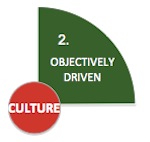
We all have a multitude of reasons for producing content. This can range from subjective motives such as a personal desire to raise your brand profile, the simple want to share information and insight and, for some with no experience, to prove your worth as a content marketer and industry expert.
For businesses, content production has to be objectively driven with a clear aim and crystal message. Quality content must serve a purpose.
- Ensure that before you start your content creation process, you agree on your aim. Is this to deliver timely insight and data, meet a set business objective or goal, support a marketing message, or match a product innovation to a market need?
- Once you’ve established your aim and gained buy-in from relevant stakeholders in your business across sales, client, product and marketing services you can then, and only then, begin to craft your message and think about assets.
This is a critical stage of the content process and it is where many companies can come unstuck. If you don’t establish the aim and key message you will waste vital content time and resource. Bottlenecks are created as stakeholders go back and forth editing multiple versions of content and messaging.
This is something I like to call “Version 30” syndrome.
Essential Further Reading:
Ensuring that you set your objectives (aim, message and goals) – brand awareness, product marketing, demand generation, sales creation, customer marketing and thought leadership – allows you to then focus on how your business can efficiently build assets/content forms that engage with your audience and scale production within your business efficiently.
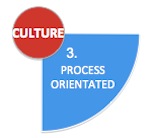
This is without doubt the biggest challenge that businesses face. Content can fall flat without a rigid process in place for content production, curation, and distribution.
We live in a world where everyone wants to be a content marketer. Everyone has a point to prove and wants to add value to the content chain.
For some, there is a genuine reason and genuine experience and value. For others it is subjectively driven, political focused, and actually devalues the quality of content.
Anyone can produce content. Put a pen to paper and there you have it! Note: It may be crap though!
Producing quality content (in line with 1 and 2 above) is a whole different ballgame where set playbooks don’t apply. Creative process applies.
- Ensure that you have a process in place that allows you to create compelling content using your brightest minds. Manage your content marketing talent.
- Differentiate between accountability and ownership. Have clear steps in place during the content production process to ensure one person has accountability and drives production of the content.
- Ownership is when multiple stakeholders need to become involved (product, design, and so forth). The person accountable for content creation transfers ownership of key areas and project manages accordingly.
- If you work with external parties (such as additional content creators, designers, social and PR partners) then make sure that they are part of this process and managed in line with the above three points. Your business should drive this process.
- Process is an area where strategy and tactics unite. Clear processes ensures that they sync together efficiently for scale.
- Ensure that you have the right people producing and leading content production. Have clear timescales and processes in place for design and asset building.
- Set clear processes in place for production and distribution that involves including the right people (skill and mindsets) at the right time. Your business and content team will include a number of left and right brain thinkers.
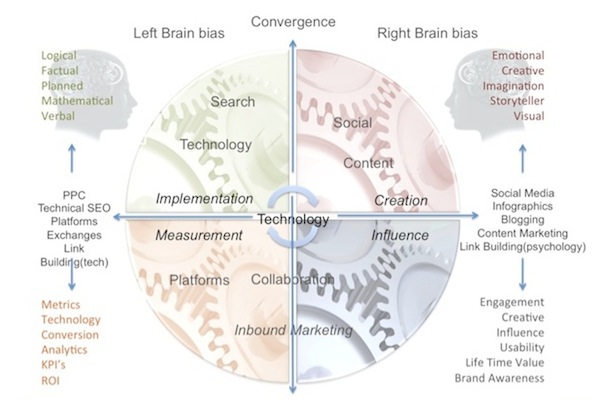
Essential Further Reading:
The content creation, curation, and distribution process is where strategists and master tacticians thrive. Creative rules in this environment. From co-created, crowds-sourced and co-branded through to visual, social and influence based search and strategies and tactics – now is the time to shine. In order to “shine,” you need to measure.
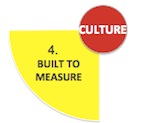
Not everything you do around content can be numbers driven. However, everything you do around content, search and social should be built to measure. Search, social and content marketing are interlinked so it is important to measure different things as part of a bigger picture process.
- Set measurement goals in line with your business objectives and goals.
- Map metrics to various stages of your user journey.
- Ensure that social media metrics lead/play a large role in your content performance evaluations.
- Utilize combinations of search, social, analytics and internal (CRM/CMS) tools to make a start on tracking your content performance from creation to revenue.
- Content, search and social – there is always a metric to measure so utilize various tools and platforms and build your own measurement system.
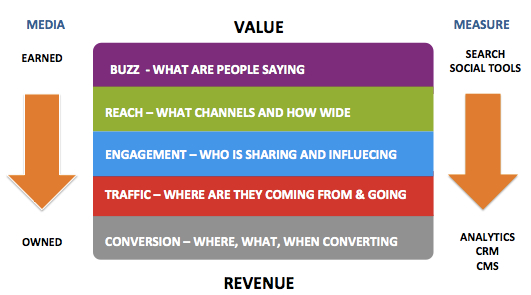
Essential Further Reading:
Conclusion
When people ask me “why does x produce so much more content than y” and “how does x create so much engagement and drive z amount of demand,” I always highlight three things that effective content marketing businesses have:
- A community culture of content across all its organization – creators, collaborators and authors – no content silos. It isn’t just the role of marketing to produce content.
- A streamlined set of processes for the management of talent and production and distribution of content across multiple business functions.
- A systematic way of measuring content value at each stage of it’s consumption, amplification, engagement and journey through the user journey and your internal business journey/targets.
Smart businesses build strong content cultures.
Strong cultures and clear processes make scaling quality content an achievable and enjoyable process for everyone involved. Without a culture of content businesses produce hectic, reactive, hub-and-spoke content that often falls short of the mark in terms of aims and objectives.
If you master the four steps above, then your content will scale organically and efficiently – the content halo.
Author’s Note: Hat tip to Alex and Anna Moss at Firecask for helping me check this and keeping me sane whilst I wrote this.








